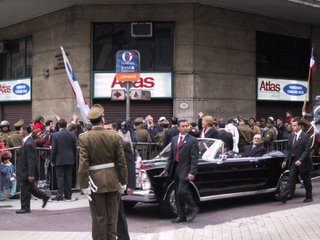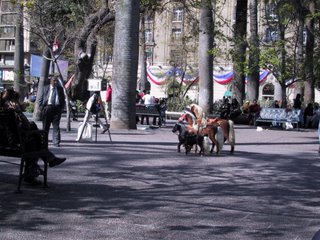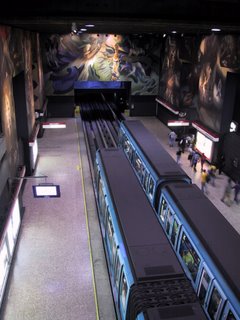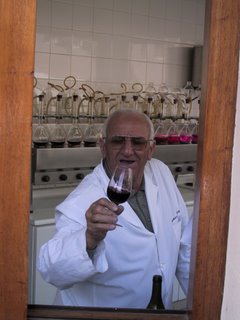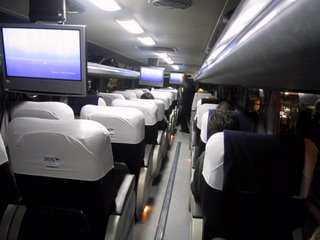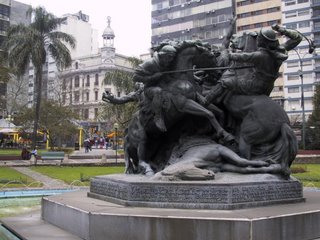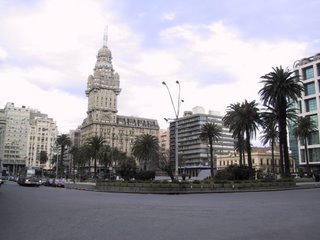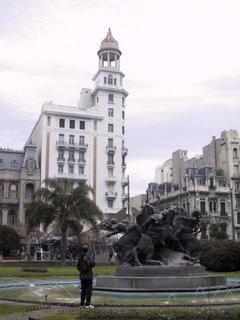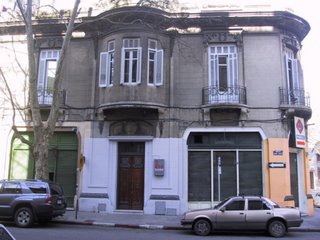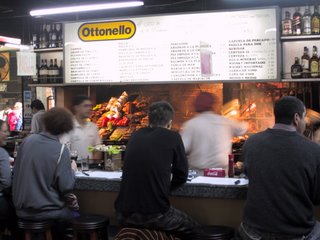Mendoza - Alta MontañaSaturday 9 September 2006
(
Alta Montaña Photos)
Now there is a lot more to this area than just the city of Mendoza. Mendoza is the base for doing a number of tours and activities, from going up into the Andes to numerous vineyards and bodegas (wineries). Equally there is a great number of travel agencies and tour operators ready to take your money. And they all seem to offer the very similar sounding tours for very similar prices. Generally it is easiest to go with the advice of your hostel. But, I also visited some of the various agencies.
The Alta Montaña tour is a popular day trip along Ruta 7, the main road that crosses the Andes to Chile (it actually starts in Buenos Aires). Needless to say, it is breathtakingly scenic route and the tours go up to the frontier, weather permitting. In the end I went with a company called Campo Base, which also runs one of the HI youth hostels here in the city. And for A$50 (US$16) you are collected from you hostel at 7:30am, go up and down the route and then dropped back at about 7:30pm. So it is a long day, but good value.
There were 18 of us in the Campo Base Mercedes mini-van. Chipi (Francisco), a very friendly and informative Rastafarian wannabe Argentinian was our guide and Luis, our lead footed driver. I think I must have been the oldest on the bus, aside from Luis. The average age was early 20's (we all had to introduce ourselves at the start of the trip).
The tour really started as we begin to ascend through the "pre-cordillera", making our first stop at a small stone bridge apparently used by General San Martin and his army. It is remarkable good condition considering its age and the the fact that hordes climb on it daily. It is just off Ruta 7 and I do not remember it being sign posted.

The Route 7 climbs up the valley formed by the Rio Mendoza, the same river that brings water from melted snow and ice, to the city and surrounding area. We passed a large reservoir (or dike) built to collect some of this water as reserve if ever there is a winter with little snow. A low area of the pre-cordillera was flooded to make the reservoir, displacing 40 families. Soon after it was built, some Japanese engineers with experience in construction in earthquake prone zones visited the area. When they saw one of the reservoir walls they said that if there ever was another serious earthquake the wall could fail, inundating the city of Mendoza.
We then proceeded to Uspallata, the last town of any significance before you really get up into the mountains. Here we had the option of hiring snow boots. Having faithing in my "Gore-Tex" lined Salomon sneakers, I turned down the boots. Foolish? I would find out soon enough.
For a major international road Ruta 7 is in surprisingly poor condition. It is fairly heavily traveled by trucks and buses. I was amazed that there was no toll. Every main route in Argentina seems to have a toll every 50km! I later learned that a law was passed by the provincial government of Mendoza banning tolls on roads in the province. Well, Mendoza, this road could do with some help.
We were accompanied all the way by the long since abandoned 252km trans-Andean railway, which connected Mendoza and Chile. The line was built by Juan and Mateo Clark, two Chileans of English decent at the turn of the 20th century. The single track, narrow gauge (1000mm) line appeared to be mostly intact, though rockfalls and small landslips have broken the line at various points. However, as I write there are plans afoot to re-open the line. Yesterday, the presidents of Argentina and Chile met at a winery (the Chilean president's favorite winery apparently) here in Mendoza to sign an accord regarding the re-building of the railway. This project has been talked about for some time, and the proposed budget keeps increasing (surprise, surprise). If it ever comes to fruition, it will be one of the most spectacular railway journeys on the continent.

By 11am we made it to about 2900m a.s.l., and we were surrounded by snow. This is the highest altitude that I have ever ascended to, an achievement that was very exciting for me (I know this is nothing to you serious trekkers and climbers out there). This stop on the tour, the furthest we went along Ruta 7, was supposed to offer a view of Mount Aconcagua. At 6959m, Aconcagua is the highest peak in all of the Americas (North included). Sadly, her peak was shrouded by cloud. However, I was not terribly bothered by this. I was on a serious high (no pun intended) just being up here, walking through deep, virgin snow, breathing in the fresh air and taking in the amazing views. I could just slightly feel the effects of the altitude, even at this low-ish level. I could sense a pressure on my ears and slight breathlessness as we took a short hike through the snow.

From here we commenced our descent, making a couple of stops along the way. One of the main landmarks along the route is the Puente del Inca.The Puente del Inca is a natural arch over the Rio Mendoza. Its formation may have had something to do with the nearby hot springs and ice. The sulfur from the springs give it its characteristic bright ochre colour. A hotel was built close by, but was destroyed by a rock slide.

Continuing down the route we stopped at Los Penitentes, a very small ski resort on Ruta 7, for lunch. A very generous group of young Porteños (as the residents from Buenos Aires are known) shared their lunch with me. We sat and enjoyed the warmth of the sun and pristine white vista from the patio of the proportionally (to the resort, that is) small youth hostel.
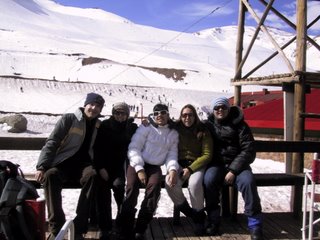
Anyone heard of the film "Seven Years in Tibet"? It was actually filmed here in this area, not far from Ruta 7. I have not seen it, but I guess I now have a reason to rent it. Another incident, aside from Brad Pitt filming in the area, occurred 1972 when a Uruguayan air force twin turboprop crashed in the mountains near the border between Chile and Argentina with a Uruguayan rugby team. Some of you may have read the book or seen the subsequent move "Alive".
This drive along Ruta 7, up to the Chilean border must be one of the most dramatic in Argentina. The Alta Montaña tour is definitely a "must do" tour when you come to Mendoza. I can also report that the sneakers kept my feet warm and dry. However, they did not stop the snow from coming in over the top!
You can find a few more photos
here.















